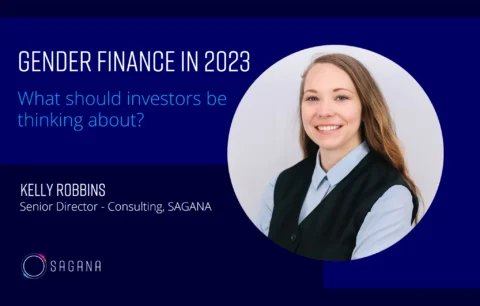The Sagana team sat down with our own Kelly Robbins, Senior Director of Consulting for a chat on what’s next for gender finance in 2023.
Gender finance received much more attention in 2022 than ever before. In your view, what is the key takeaway for investors from the year?
It was clear both through publications on this topic, such as Gender Smart’s Gender Lens Investing State of the Field 2022, and in our conversations with investors, that the myth persists: the idea that engaging on topics around women and women’s empowerment means you are talking about lower or concessionary financial returns. We know this is not the case, and not only has it been proven across the board from investors’ results and through research, but also the growth of private capital focusing on gender-smart investing in the private markets – according to Catalyst at Large and Wharton Social Impact Initiative’s Project Sage, there were 206 funds in this space in December 2021, representing a 49% growth since July 2020 and a 255% growth since October 2017.
We know that gender diverse teams deliver 10-20% more in net IRR. For investors that are themselves gender-smart within their own teams, who have made commitments to increase the proportion of female partners and staff at their own firms, returns on investment are clearly higher. And since less than one third of venture capital investments are exited profitably at all, this is really significant for the returns and performance of their funds.
It also matches with our general intuition – the more diversity you have in a portfolio, the more perspectives you see and the more innovation you’ll get. In addition, the more focused we can be on the risks and opportunities that others are not considering, the better we’ll be as investors.
So, the takeaway for investors is that the fact that gender-smart investing is a smart financial decision. And that it’s time to begin thinking about starting the journey now.
With this groundswell of action into gender finance, many investors can feel like they should be doing something, but they don’t really know how or have the time to give it attention. What pointers can you give investors who are ready to get started on gender-smart investing?
One of the biggest barriers we’ve seen is the belief that to start gender-smart investing you or your team need to be an expert in a new subject: either on gender or women entrepreneurs. This is a pretty high bar for investment officers who are already experts in the area where they have spent most of their careers and where their investment strategy is already focused.
For example, many specialists with deep technical and scientific expertise in climate investing do understand it is important to consider women in climate justice and net zero work. So, do they need to now also become gender experts?
I personally don’t think this is the ideal approach. Gender-smart investing absolutely requires special analytical techniques and expertise, but not everyone in an organization needs to be an expert in this. Instead, it could start with looking carefully at how inclusive your process is – in partnership with consultants or peers who have gone through this journey before. It could mean adding some specific and discrete skills at different levels across the teams, which is a matter of training. But it certainly isn’t about hiring a new person or going out to get a new degree.
For example, arming your investment officers with a couple of questions they can use to kickstart the conversation with prospective investees in your pipeline. These questions can be an important way to start signaling to your portfolio and pipeline how important gender performance is to you.
Similarly, at the senior leadership level of a fund manager or investor, there may be some specific skills relevant for your investment vehicle or sector. For example, gaining a strong grasp of what legal terms might be included, to protect women’s positions within their own companies. Again, that’s not something that requires a long term investment in the expertise, but digesting the growing expertise and advice in the industry, such as research being developed by the Hogan Lowells and 2X project Aurora.
Looking ahead, what are some of the top trends in gender finance for 2023?
There are a few trends, but one I’m particularly excited about is the connection between climate finance and gender-smart investing, which has been a hot topic in the last year, most recently at COP27, and which will certainly continue in 2023.
We’re not only becoming clearer that we need to think about both, but our thinking is also becoming more sophisticated about the different ways in which climate and gender connect. There’s a huge amount of nuance here, but we are asking ourselves “how can women contribute to the most effective use of climate finance?” In other words: how do we include women in a way that ensures we reach the climate results we need as quickly as possible?
For example, once we’ve prioritized the climate goal, we need to consider how engaging with women can assure that we reach the goals for our climate investments. This could be focused on the increase in innovation that comes from increased diversity, as I mentioned before. This gives us a very good incentive to think about how women’s representation on R&D teams or in STEM roles at companies working on climate tech can make those companies more likely to arrive at successful, scalable solutions because they’ve designed products and services with male and female consumers or users in mind.
We’re also thinking about climate justice: when prioritizing the social goals around equity for women, girls and intersectional groups, we have to think about how we use climate finance in a way that at a minimum doesn’t harm them like previous systems of power have. Ideally, achieving climate goals also increases equity for those who have historically not been able to participate.
One way to think about this, which is important, is resource management. Poor resource management has led us to the climate problems we’re currently in and our focus now is about how to conserve the resources we have or transition to renewable resources. Alongside this, we need to consider who has power and a voice when we decide how resources are used and who uses them, as well as who is downstream from their use. This is the critical piece of the puzzle where gender-smart investing guides our thinking about who does and does not benefit from new solutions.
Any other shifts you’re noticing in the sector?
Yes, definitely a greater consideration of and thinking about intersectional groups – so the intersection of gender and other minorities and oppressed groups, including identities like race and sexuality. This is something I’ve seen change over the course of my career, which began with a very clear focus on women, and in my case, women in emerging economies. At that point, considering women and girls was already a step forward. It’s encouraging to see the number of investors and fund managers who are now also interested in the intersectionality of gender and race, ethnicity, disability, or sexuality.
Seasoned gender lens practitioners, both advisors and investors, have shifted towards thinking more intersectionally about power dynamics overall rather than only about the oppression that has been suffered by women. This is also reflected in a general shift among newer entrants to gender-smart investing, who are approaching the sector at a time when it’s already more nuanced.
This is all positive, but I think we also need to acknowledge there’s lots more work to be done and gender-smart investing does need to make a conscious effort in thinking about whether our approaches particularly favour white women, for example. So there are some important steps forward still to be made in gender-smart investing.
How should investors be tackling measurement and evaluation for gender finance?
To begin, clearly your approach to measurement is going to be different depending on your sector and your financial instrument. There are lots of things that can shape what you measure including which metrics you choose. However, one of the key things I have learned over the years is to take a step back and consider, “what am I trying to prove or improve?”. This step can be easily missed in gender-smart investing conversations where we can fall into the trap of thinking that it’s just about counting the number of women.
We should really be looking at metrics that are related to the things we find most important, inspiring, or moving – that is, the reason behind the impact we want to have. Usually, the thing that needs to be proven – or tracked so it can be improved – is the part of what you’re doing that is completely new.
Let’s take an emerging market example from financial inclusion, which is a space where a lot of gender-smart investing is focused and where historically I think we have been guilty of just counting how many women get loans. So, let’s say a bank wants to increase the number of loans going to women or the value of loans to women. Whole programs and credit lines are designed around this. At the end of the day, the metric collected is how many women borrowers does the bank have.
But there are more important things to prove, and that metric only answers whether we designed a program that will reach more women than the way we did banking before. Instead, we could look at other much more interesting metrics that demonstrate how we are benefitting women’s lives.
By looking at the longevity, or the lifetime value of these clients, you could then demonstrate that the program or loan was designed to encourage women to have a deeper relationship with this financial institution – a longer one and where she might take advantage of other products that further help to improve her life financially. This could include a savings account, education loan, or insurance for her children’s health. Counting how many loans go to women doesn’t give us insights about the impact on her life or about her value as a customer of the bank. We would only be able to learn more deeply about this by counting how many bank products each female client uses before and after the program began. More creative measurement is key – and it starts with thinking about what difference we want to make in the business and the world.
Ultimately, impact investors seeking to catalyze new approaches need to ask themselves what is innovative about the kind of impact they’re trying to create: what are you trying for the first time in your market or even globally? These are the things that will enable you to prove it worked and is scalable, or it didn’t work but you tweaked it. This is what measurement is really good for…but it’s not always what measurement gets used for – and that’s something that I would like to see change in the coming year.





